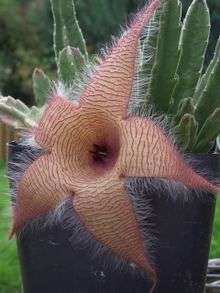Stapelia gigantea
Stapelia gigantea is a species of flowering plant in the genus Stapelia of the family Apocynaceae.[1] Common names include Zulu giant,[2] carrion plant and toad plant (although the nickname "carrion plant" can also refer to Stapelia grandiflora). The plant is native to the desert regions of South Africa to Tanzania.[3]
| Stapelia gigantea | |
|---|---|
 | |
| Carrion plant flower | |
| Scientific classification | |
| Kingdom: | Plantae |
| Clade: | Tracheophytes |
| Clade: | Angiosperms |
| Clade: | Eudicots |
| Clade: | Asterids |
| Order: | Gentianales |
| Family: | Apocynaceae |
| Genus: | Stapelia |
| Species: | S. gigantea |
| Binomial name | |
| Stapelia gigantea | |
| Synonyms[1] | |
| |
Description
Growing up to 20 cm (8 in) tall, it is a clump-forming succulent with erect green stems 3 cm (1.2 in) thick. The blooms are large star-shaped five-petalled flowers up to 25 cm (9.8 in) in diameter. The flowers are red and yellow, wrinkled, with a silky texture and fringed with hairs, that can be as long as 8 mm (0.3 in). The flowers of this plant bloom in the Fall season, triggered by the shorter daylight hours.[3]
They have the smell of rotting flesh,[4] in order to attract the flies which pollinate them. Because of the foul odor of its flower, S. gigantea can act as an appetite suppressant in humans.[5]
There have been several proposed reasons for the size of the flowers of S. gigantea. First, it is possible that they are large to attract the flies that pollinate it.[6] The largeness and color of the flower combined with the carrion smell may serve to make the flies think that it is a dead carcass and be more likely to visit it.[6][7] It has also been proposed that these large flowers could work as thermal regulators, much like the large ears of a Fennec fox.
Cultivation
Since it does not tolerate temperatures below 10 °C (50 °F) for extended periods, this plant must be grown as a houseplant in temperate zones. It has gained the Royal Horticultural Society's Award of Garden Merit.[8][9]
Ecology
S. gigantea can become an invasive plant when introduced in arid and semi-arid environments, although it has been found to facilitate the recruitment of nurse-dependent native taxa, those that require a suitable microhabitat created by another plant for successful germination, growth, and/or survival from impacts such as herbivory.[10]
Gallery
 Flower and Plant
Flower and Plant- Stems
- Stems
- Flower and bud
References
- "Stapelia gigantea". World Checklist of Selected Plant Families (WCSP). Royal Botanic Gardens, Kew. Retrieved 2018-11-13.
- "Stapelia gigantea". Natural Resources Conservation Service PLANTS Database. USDA. Retrieved 1 December 2015.
- "Stapelia gigantea". Missouri Botanical Garden. Retrieved 2018-11-12.
- RHS A-Z encyclopedia of garden plants. United Kingdom: Dorling Kindersley. 2008. p. 1136. ISBN 1405332964.
- Corley, David Gregory; Miller, James (Mar 7, 2006), Plant derived or derivable material with appetite suppressing activity, retrieved 2016-09-28
- Johnson, and Jurgens. "Convergent evolution of carrion and faecal scent mimicry in fly-pollinated angiosperm flowers and a stinkhorn fungus". South African Journal of Botany. 76.
- Davis Endress, and Baum. (2008). "The evolution of floral gigantism". Current Opinion in Plant Biology. 11: 49–57. doi:10.1016/j.pbi.2007.11.003. PMID 18207449.
- "RHS Plant Selector - Stapelia gigantea". Retrieved 5 July 2013.
- "AGM Plants - Ornamental" (PDF). Royal Horticultural Society. July 2017. p. 99. Retrieved 21 November 2018.
- Herrera, Ileana; Ferrer-Paris, José R.; Hernández-Rosas, José I.; Nassar, Jafet M. (2016). "Impact of two invasive succulents on native-seedling recruitment in Neotropical arid environments" (PDF). Journal of Arid Environments. 132: 15–25. doi:10.1016/j.jaridenv.2016.04.007. Retrieved 6 May 2016.